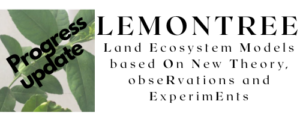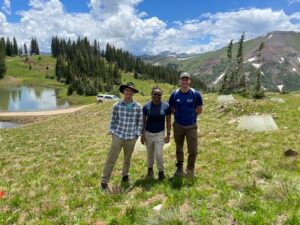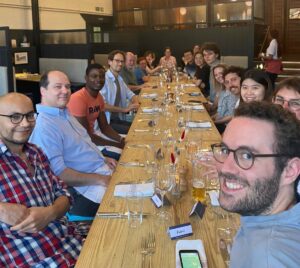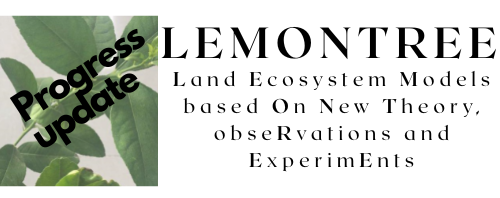
Back in July, we posted a blog on the LEMONTREE 1st-year progress report. It has been an incredibly busy summer with fieldwork carried out in the Rocky Mountains to test EEO theory along elevational gradients, experiments undertaken in laboratories at UWA to look at stomatal conductance and biomass allocation, several conferences attended and 13 papers written. We have just submitted our latest report so here is a very quick summary of our research and activities from April to September 2022. Just click on the links to read more about each item.
Science Progress
Challenge 1: Optimality at the leaf and plant level
Our focus over the last few months has been on respiration:
- Leaf dark respiration. We tested our hypothesis that leaf dark respiration (Rd) at a standard temperature of 25°C (Rd,25) should acclimate to night-time temperatures to maintain sufficient carboxylation capacity (Vcmax) for the use of all available light in photosynthesis. We found that Vcmax optimization dominated the spatial patterns and acclimation (of two weeks) reduced the response of night-time respiration to warming by 50% globally.

The TTU team near Cinnamon Mountain in CO, USA. Left: Nick Smith, center: Zinny Ezekannagha, right: Brad Posch. (Photo credit: Rose Brinkhoff)
- Stem respiration. We have conducted a novel analysis of diverse experimental data on stem respiration and shown that it acclimates to the average growing season temperature to the extent also predicted by our optimality theory.
Challenge 2: Biophysical coupling of atmosphere, water and land.
- Fluxnet data kit: We have developed a spatial product of gross primary production (GPP) based on flux observations that represent a significant improvement over the existing product. Novel aspects of this work include incorporating the effect of CO2 on photosynthesis using machine learning and improving the representation of interannual variability and responses to extreme events.
- Remote-sensing data kit: Progress has been made in developing the remote-sensing data kit to include datasets such as cleaned and gap-filled MODIS (LAI, fAPAR, NIRv), BESS (radiation, GPP, Rec, NEE, ET), Phenology and peak LAI, LCSIF, GOES LST and GPP, longterm AVHRR-MODIS (red/ NIR reflectance, NDVI, NIRv, SIF, VOD and biomass).
Challenge 3: Ecosystem properties and biochemical cycling.

Nitrogen limitation. Our analyses of experimental and field data have shown that the relationship between leaf nitrogen and photosynthesis is not static under varying levels of soil nitrogen availability: the fraction of leaf nitrogen allocated to photosynthesis decreases as soil nitrogen availability increases. Most models do not account for this. Our investigations, including new results from greenhouse experiments, have uncovered important issues that have been neglected both in the plant functional ecology literature and in current models. One is that spatial gradients of soil nitrogen availability persistently fail to manifest in field-measured photosynthetic capacity. Another is that nitrogen addition experiments induce increases in photosynthetic capacity in some species and not others – we are seeking the pattern behind this. The LEMONTREE Nitrogen Working Group is developing a paper that will summarise the current understanding of nitrogen uptake and allocation that will form the basis for a better implementation of the role of nutrients.
Challenge 4: From Plant function, biophysics and biogeochemistry to land-surface and climate modelling.
In the last few months, we have started work on improving the VIC+ model, to create the VIC++ model. So far, we have
- added an option to unevenly discretize the soil layers for better computation of subsurface flow and groundwater table (GWT) dynamics
- coupled CASA to VIC+ which provides a baseline to compare with the results of the coupling of the P-model to VIC+
- implemented the least-cost optimality theory for stomatal conductance in water-stress conditions.
Scientific Outreach

Since our last progress report blog, we had the MMEE conference at Reading University in July, followed by the first in-person LEMONTREE annual meeting. It was great to get the team together, share progress and ideas and plan for future research. Trevor presented at the FluxCourse from the 25th July- 5th August, and three PhD students presented at the Ecological Society of China Annual Meeting and were all awarded prizes for their talks. Poster presentations were given at the Ameriflux Annual Meeting in September and the ICOS annual meeting. Colin and Sandy presented at the Land Surface Modelling Summit and Colin at the JULES Science Meeting.
Scientific papers

Since April, we have had a further 6 papers published, 1 in-press and 6 more in review. Here is the list of our latest publications with the LEMONTREE team in bold:
- Dong, N., Prentice, I.C., Wright, I.J., Wang, H., Atkin, O.K., Bloomfield, K.J., Domingues, T.F., Gleason, S.M., Maire, V., Onoda, Y., Poorter, H. Smith, N.G., 2022. Leaf nitrogen from the perspective of optimal plant function. Journal of Ecology https://besjournals.onlinelibrary.wiley.com/doi/full/10.1111/1365-2745.13967
- Zhu, Z., Wang, H, Harrison, S.P., Prentice, I. C., Qiao, S., Tan, S., 2022. Co-limitation theory explains divergent responses of alpine vegetation to recent climate change. Global Change Biology. https://onlinelibrary.wiley.com/doi/10.1111/gcb.16459
- Haas, O., Prentice, I.C., Harrison, S.P., 2022. Global environmental controls on wildfire burnt area, size and intensity. Environmental Research Letters 17, 065004, https://iopscience.iop.org/article/10.1088/1748-9326/ac6a69
- Fu, Z., Ciais, P., Prentice, I.C., Gentine, P., Makowski, D., Luo, X., Bastos, A., Green, J.K, Stoy, P.C., Yang, H., Hajima, T., 2022. Atmospheric dryness reduces photosynthesis along a large range of soil water deficits. Nature Communications 13, 989, https://doi.org/10.1038/s41467-022-28652-7
- Dong, N., Wright, I.J., Chen, J.M., Luo, X., Wang, H., Keenan, T.F., Smith, N., Prentice, I.C. (2022). Rising CO2 and warming reduce global canopy demand for nitrogen. New Phytologist, 235: 1692-1700, https://doi.org/10.1111/nph.18076
- Chen, J.M., Wang, R., Liu, Y., He, L., Croft, H., Luo, X., Wang. H., Smith, N.G., Keenan, T.F., Prentice, I.C., Zhang, Y., Ju,W., Dong, N., 2022. Global datasets of leaf photosynthetic capacity for ecological and earth system research. Earth System Science Data 14, 4077-4093, https://essd.copernicus.org/articles/14/4077/2022/
- Marqués, L., Hufkens, K., Bigler, C., Crowther, T.W., Zohner, C.M., and Stocker, B.D. (in press). Acclimation of phenology relieves leaf longevity constraints in deciduous forests. Nature Ecology and Evolution.
- Bloomfield, K. J., Keenan, T.F., Stocker, B.D., Prentice, I.C. (in revision) Environmental controls on the light use efficiency of terrestrial gross primary production. Global Change Biology.
- Yan, Z, Detto, M., Guo, Z., Smith, N.G, Wang, H., Albert, LP., Xu, X., Lin, Z., Liu, S., Zhao, Y., Chen,S., Bonebrake,T.C., Liu, L., and Wu, J. (in review) Global photosynthetic capacity jointly determined by enzyme kinetics and eco-evolutionary processes. New Phytologist
- Lavergne, A., Harrison, S.P., Prentice, I.C. (in review) Predicting C3/C4 plant competition and primary production using optimality principles. Global Ecology and Biogeography.
- Stocker, B.D., Tumber-Dávila, S.J., Konings, A.G., Anderson, M.B., Hain, C., Jackson, R.B. (in review). Plant access to deep water storage inferred across a third of the Earth’s vegetated surface. Nature Geoscience.
- Qiao, S., Harrison, S.P., Prentice, I.C., Wang, H. (in review) Optimality-based modelling of wheat sowing dates globally. Agricultural Systems.
- Kladmy, K.-R., Milanta, M., Mraz, O., Hufkens, K., and Stocker, B.D. (in review). Deep learning for satellite image forecasting of vegetation greenness, Environmental Data Science.
We have said goodbye to Azin Wright, Nathanael Harwood, Alienor Lavergne and Markus Todt who have left the project. But we have welcomed several new members to the team: Daniel Adigun (data manager), Georgina Tang and Paarbrahm Singh (research assistants), Maoya Bassiouni (at Berkeley), Natalie Sanders (communications manager) and Paul Drake (UWA).

Thanks as always to the generosity of Eric and Wendy Schmidt by recommendation of the Schmidt Futures program for funding the LEMONTREE project.

